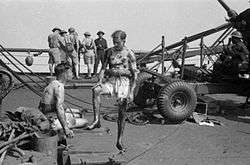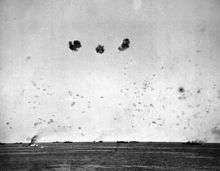HMS Manchester (15)
_1942.jpg) Manchester in 1942 | |
| History | |
|---|---|
| Name: | HMS Manchester |
| Builder: | Hawthorn Leslie, Hebburn |
| Laid down: | 28 March 1936 |
| Launched: | 12 April 1937 |
| Commissioned: | 4 August 1938 |
| Fate: | Scuttled after being damaged by Italian MAS boats on 13 August 1942 off Cap Bon,Tunisia |
| General characteristics | |
| Class and type: | Town-class light cruiser |
| Displacement: | 11,930 tons full load |
| Length: | 591 ft 6 in (180.29 m) |
| Beam: | 64 ft 9 in (19.74 m) |
| Draught: | 20 ft 6 in (6.25 m) |
| Propulsion: |
|
| Speed: | 32 knots (59 km/h) |
| Range: | 7,320 nmi (13,560 km; 8,420 mi) at 13 kn (24 km/h) |
| Complement: | 750 |
| Sensors and processing systems: |
|
| Armament: |
|
| Aircraft carried: |
|
| Notes: | Pennant number C15 |
The second HMS Manchester was a Town-class light cruiser of the Royal Navy, belonging to the Gloucester subclass. She was laid down by Hawthorn Leslie at Hebburn in March 1936, launched in April the following year and commissioned in August 1938. She had a relatively short, but active, career.
Early war service
Manchester was serving in the East Indies with the 4th Cruiser Squadron at the outbreak of war, but was ordered home and arrived back Britain on 25 November 1939. She subsequently served with the Home Fleet at Scapa Flow, on Northern Patrol duties, capturing the German merchantman Wahehe on 21 February 1940. She first saw action during the ill-fated Norwegian campaign in 1940, where she won her first battle honour. She was then based in the Humber for anti-invasion duties, but on 15 September sailed to the Mediterranean for Operation Collar. In 1940, Manchester, along with other Royal Navy warships, engaged an Italian cruiser squadron, in a naval action that became known as the battle of Cape Spartivento. During the engagement, Manchester was straddled by the main guns of the Italian battleship Vittorio Veneto and hit by shell splinters.[1]

Bismarck and the Mediterranean convoys
Manchester returned to Britain on 13 December 1940 and spent the first four months of 1941 under refit, then patrolled the Iceland-Faroes passage during the Bismarck sortie. In July she returned to the Mediterranean for an important Malta convoy, but on 23 July she was hit on the port quarter by an Italian aerial torpedo and badly damaged. Temporary repairs were made at Gibraltar, and the ship then sailed for Philadelphia for complete repair. This was finished on 27 February 1942, after which she returned to Portsmouth, where final work was completed by the end of April. On her return to service she joined the Home Fleet at Scapa Flow during the first week of May, then carried out Russian convoy cover duties and the reinforcement of Spitzbergen.
Sinking
In August 1942 she returned to the Mediterranean and took part in Operation Pedestal. The operation, designed to supply the besieged island of Malta, cost several warships including the aircraft carrier Eagle. In the early hours of 13 August during the operation Manchester was torpedoed and disabled by two Italian motor torpedo boats MS 16 and MS 22 and subsequently scuttled with explosive charges.[a] She was the largest warship sunk by motor torpedo boats during the Second World War.[2]

Aftermath
Her commanding officer, Captain Harold Drew, was court-martialled due to the Admiralty's belief that the ship was still navigable and capable of reaching a neutral port. Captain Drew was initially led to believe that he was taking part in an enquiry, and was only informed at the end of the trial that he was in fact being charged with negligence by a court martial.[3] He was found guilty, and was reprimanded and dismissed. It was and remains a contentious decision; the ship had been crippled, and the Captain had feared the ship, including her radar gear, might fall into enemy hands. Many of the ship's crew were rescued by an Allied warship. Others, including Nigel Malim, fell into the hands of the Vichy French and were interned at Laghouat,[4] to be released in November as a result of Operation Torch. Notably, the surviving crew members strongly supported both Captain Drew's assessment of the ship's situation and his decision to scuttle her, with one seaman stating: "We were down to 10-15% ammunition, listing at nearly 45 degrees, with one engine destroyed and not much hope of getting the other working. The Captain decided that his choices were to wait until dawn and get blown to buggery, or to save the men."
In 2002, Manchester was the subject of a documentary by ITV, called "Running the Gauntlet: Sink the Manchester!".
In 2009, a successful expedition to dive Manchester was completed.[5]
Battle honours
- Norway 1940
- Spartivento 1940
- Malta 1942
- Arctic 1942
See also
Notes
a. ^ There is some disagreement about Manchester's fatalities among the sources: The following websites mention 150 "lost":
- "Royal Navy Cruisers - Part 4". Alex's Royal Navy Page. Archived from the original on 11 July 2012.
- "HMS Liverpool - Town Class Light Cruisers". The Naval Ships of Victor Johns. Retrieved 27 June 2013.
A more accurate account of the cruiser casualties reports 132 killed or missing and 568 survivors (rescued either by Allied forces or Vichy authorities).[Kemp, Paul:The Admiralty Regrets: British Warship Losses of the 20th Century, Sutton Publishing,1999].
Other sources only mention the deaths as result of the torpedo impact (about a dozen). [Woodman, Richard: Malta Convoys, 1940-1943, Jack Murray Ltd., London, 2000].
Citations
- ↑ Stern, Robert C. (2015). Big Gun Battles: Warship Duels of the Second World War. Seaforth Publishing. p. 63. ISBN 1473849691.
- ↑ Malvezzi, Pierluigi. "MAS, VAS and MS". Regia Marina Italiana. Retrieved 27 June 2013.
- ↑ "HMS Manchester". The Wartime Memories Project. Retrieved 27 June 2013.
- ↑ Rear Admiral Nigel Malim CB LVO DL at marketrasenmail.co.uk, accessed 3 July 2013
- ↑ "Sleeping giant". Diver Magazine. November 2009.
References
- Colledge, J. J.; Warlow, Ben (2006) [1969]. Ships of the Royal Navy: The Complete Record of all Fighting Ships of the Royal Navy (Rev. ed.). London: Chatham Publishing. ISBN 978-1-86176-281-8. OCLC 67375475.
- Chesneau, Roger (ed.) (1980). Conway's All the World's Fighting Ships, 1922-1946. London: Conway Maritime Press. ISBN 0-85177-146-7.
External links
| Wikimedia Commons has media related to HMS Manchester (C15). |
- HMS Manchester at Uboat.net
- HMS Manchester at World War II cruisers
- HMS Manchester at naval-history.net
Coordinates: 36°50′0″N 11°10′0″E / 36.83333°N 11.16667°E